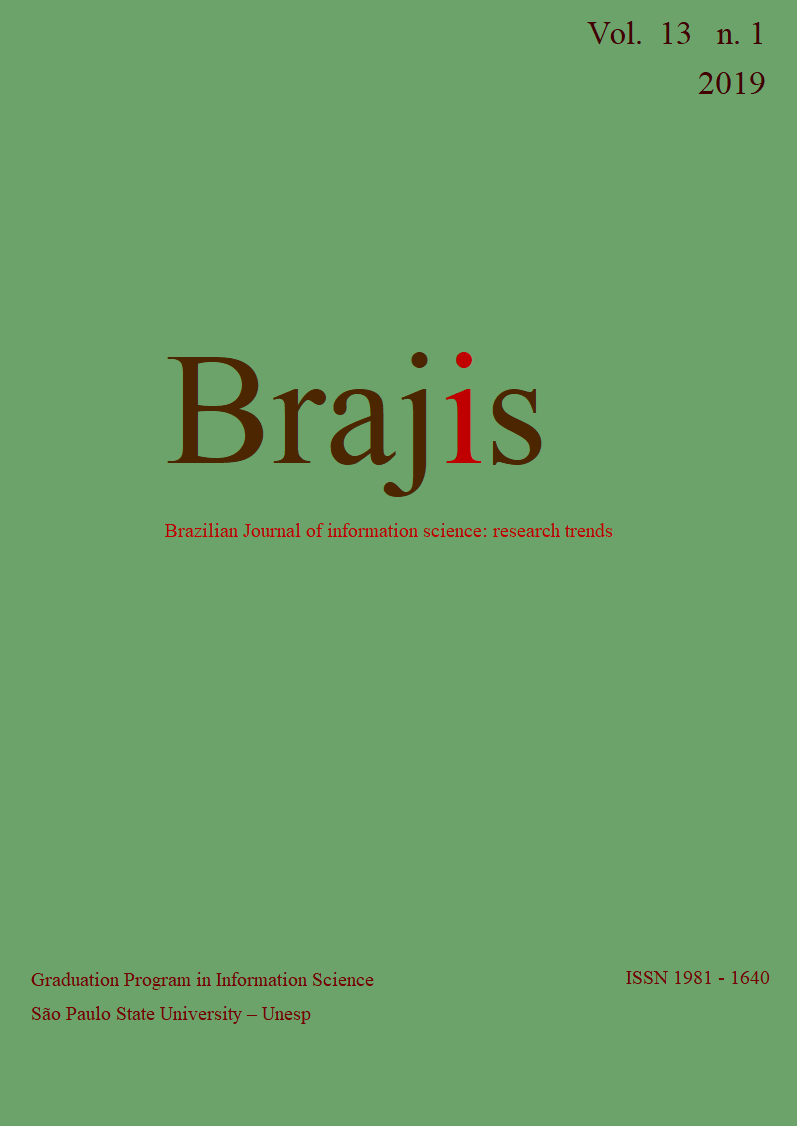Interdisciplinary perspectives in subject analysis
DOI:
https://doi.org/10.36311/1981-1640.2019.v13n1.03.p15Keywords:
Knowledge organization systems, Thesauri, Ontologies, Knowledge organization and representationAbstract
It discusses the concepts of organization and representation of knowledge as fundamentals for the understanding of thesauri and ontologies took as modalities of knowledge organization systems. The analysis of the complementarity relationships between the two instruments is necessary to reaffirm the conception that the technological and, above all, the categorial aspect brings them closer instead of isolating them. In subordinating the concepts of thesauri and ontologies to the broader concept of knowledge organization systems, it reflects on some of its theoretical and applied implications. Such reflections are guided by the way each instrument understands associative conceptual relationships. It is concluded that the technological apparatus used to characterize the concepts and their relationships in the ontologies contributes to the construction of more sophisticated thesauri from when considering the need to make explicit the concepts and the conceptual relationships that the instruments aim to establish. In another direction and in a complementary way, the categorial and faceted analysis model used in the construction of thesauri also contributes to the construction of semantically and structurally denser ontologies.
Downloads
References
Borst, Willem N (1997). Construction of engineering ontologies for knowledge sharing and reuse. Thesis (Ph.D) –Dutch Graduate School for Information and Knowledge Systems, Enschede, 1997.
Branquinho, João (2006). Compromisso ontológico. // Branquinho, João; Murcho,Desidério; Gomes, Nelson G. (Dir.). Enciclopédia de termos lógico-filosóficos. São Paulo: Martins Fontes, 2006.Clarke, Stella G. D.; Zeng, Marcia L. (2012). From ISO 2788 to ISO 25964: the evolution of thesaurus standards towards interoperability and data modeling.// Information Standards Quarterly 24:1 (Winter 2012).
Dahlberg, Ingetraut (1978). Teoria do conceito. // Ciência da informação 7:2 (1978) 101-107.
Dahlberg, Ingetraut (1995). Current trends in knowledge organization.// Garcia Marco, Francisco Javier (org.). Organización del conocimiento ensistemas de información y documentación. Zaragoza: Universidad de Zaragoza,1995.7-25.
Dahlberg, Ingetraut (2006). Knowledge organization: a new science?// Knowledge Organization 33:1 (2006) 11-19.
Davis, Randall; Shrobe, Howard; Szolovits, Peter(1993). What is a knowledge representation?// AI Magazine14:1 (Spring 1993) 17-33.
Gruber, Thomas R (1993). A translation approach to portable ontology specifications. // Knowledge Acquisition5:2 (1993) 199-220.Hjørland, Birger (2015). Arerelations in thesauri “context-free, definitional and true in all possible worlds”? // Journal of the As-sociation for Information Science and Technology 66:7 (2015) 1367-1373.
Hjørland, Birger (2003). Fundamentals of knowledge organization.// Knowledge Organization 30:2 (2003) 87-111.
Hjørland, Birger (2008). What is knowledge organization (KO)?// Knowledge Organization 35:2/3 (2008) 86-101.
International Organization for Standardization (2011). ISO 25964: information and documentation: thesauri and interoperability with other vocabularies -part 1: thesauri for information retrieval. Genebra, 2011.
Panse, Fabian (2014). Duplicate detection in proba-bilistic relational databases. Dissertation (PHD in Informatik) -Universität Hamburg, Hamburg, 2014.
Pickler, Maria Elisa V (2007). Web semântica: ontologias como ferramentas de representação do conhecimento. // Perspectivas em Ciência da Informação 12:1 (jan./abr. 2007) 65-83.
Quine, Willard van (1975). De um ponto de vista lógico. São Paulo: Abril, 1975.
Slavic, Aida; Civallero, Edgardo. (Eds.) (2011). Classification and ontology: formal approaches and access to knowledge: proceedings of the International UDC Seminar, 19-20 September 2011, The Hague, The Netherlands. Würzburg: Ergon Verlag, 2011.
Wallenius, Kalle (2010). Video annotation for studying the brain in naturalistic settings. Thesis (Master of Science in Technology) -Aalto University, Helsinki, 2010.
Downloads
Published
Issue
Section
License
When submitting an article, the authors retain the copyright of the article, giving full rights to the Brazilian Journal of Information Science to publish the text.
The author(s) agree that the article, if editorially accepted for publication, shall be licensed under the Creative Commons Attribution-ShareAlike 4.0 International (CC BY-SA 4.0) license (http://creativecommons.org/licenses/by-sa/4.0) Readers/users are free to: - Share — copy and redistribute the material in any medium or format - Adapt — remix, transform, and build upon the material for any purpose, even commercially. The licensor cannot revoke these freedoms as long as you follow the license terms. Under the following terms: - Attribution — You must give appropriate credit, provide a link to the license, and indicate if changes were made. You may do so in any reasonable manner, but not in any way that suggests the licensor endorses you or your use. - ShareAlike — If you remix, transform, or build upon the material, you must distribute your contributions under the same license as the original. No additional restrictions — You may not apply legal terms or technological measures that legally restrict others from doing anything the license permits. Notices: - You do not have to comply with the license for elements of the material in the public domain or where your use is permitted by an applicable exception or limitation. - No warranties are given. The license may not give you all of the permissions necessary for your intended use. For example, other rights such as publicity, privacy, or moral rights may limit how you use the material.
 Creative Commons Attribution-ShareAlike 4.0 International License.
Creative Commons Attribution-ShareAlike 4.0 International License.







